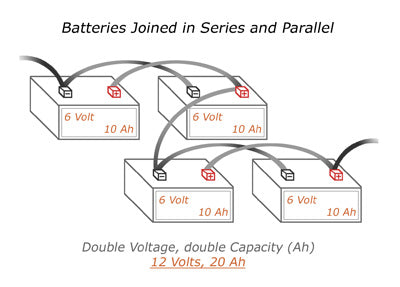Battery Banks Explained
Battery Banks - Series and Parallel
A battery bank is the result of joining two or more batteries together for a single application. By connecting batteries, you can increase the voltage or amperage, or both. When you need more power you can create a battery bank.There are 2 ways to successfully connect two or more batteries, series and parallel.
Batteries Connected In Series
Series adds the voltage of the two batteries, but keeps the same amperage rating (also known as Amp Hours). For example, these two 6 Volt batteries joined in series now produce 12 Volts, but still have a total capacity of 10 Amps.

Batteries Connected in Parallel
A battery bank connected in Parallel will increase your current rating, but the voltage will stay the same. In the diagram below, the output voltage stays at 6 Volts, but the Amps increase to 20. It is important use the correct size cables to allow for the Amp rating of the battery bank.

Batteries Connected in Series/Parallel
It is also possible to connect batteries in what is called a Series/Parallel configuration. In this configuration can increase your voltage output and current rating. To do this you need at minimum of four batteries.Imagen you have two sets of batteries already connected in parallel, you can join them together to form a series. In the diagram below, we have a bank that produces 12 Volts and has 20 Amp Hours.

Electricity flows through a parallel connection just the same as it does in a single battery. Therefore, you can connect two parallel connections in a series as you would two batteries. Only one cable is needed, a bridge between a positive terminal from one parallel bank to a negative terminal from the other parallel bank.
N.B. It important to use the same type, size and rating of battery in a bank.
